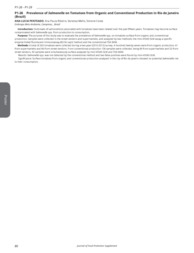Prevalence of Salmonella on tomatoes from organic and conventional production in Rio de Janeiro (Brazil).
Prevalence of Salmonella on tomatoes from organic and conventional production in Rio de Janeiro (Brazil).
Author(s): PENTEADO, A. L.; RIBEIRO, A. P. de O.; MELLO, V. F. de; COSTA, S. D. de O.
Summary: Outbreaks of salmonellosis associated with tomatoes have been related over the past fifteen years. Tomatoes may become surface contaminated with Salmonella spp. from production of consumption. Purpose: The purpose of this study was to evaluate the prevalence of Salmonella spp. on tomatoes surface from organic and conventional production. Samples were collected in the street cendors and supermarkets, and analzed by two methods; the mini-VIDAS SLM assay a specific enzyme-linked fluorescent immonoassay (ELFA) rapid method and the conventional FDA-BAM. Methods: A total of 263 tomatoes were collected during a two-year (2010-2012) survey. A hundred twenty-seven were from organic production, 61 from supermarkets and 66 from street vendors. From conventional production 136 samples were collected, being 84 from supermarkets and 52 from street vendors. All samples were simultaneously surface analyzed by mini-VIDAS SLM and FDA BAM. Results: Salmonella spp. was not detected by the conventional method and two false positives were found by mini-VIDAS SLM. Significance: Surface tomatoes from organic and conventional production analyzed in the city of Rio de Janeiro showed no potential Salmonella risk to their consumption.
Publication year: 2015
Types of publication: Abstract in annals or event proceedings
Unit: Embrapa Environment
Keywords: Salmonella, Tomate
Observation
Some of Embrapa's publications are published as ePub files. To read them, use or download one of the following free software options to your computer or mobile device. Android: Google Play Books; IOS: iBooks; Windows and Linux: Calibre.
Access other publications
Access the Agricultural Research Database (BDPA) to consult Embrapa's full library collection and records.
Visit Embrapa Bookstore to purchase books and other publications sold by Embrapa.

